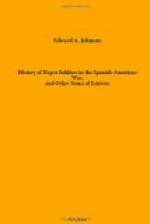The squalor in the streets was dreadful. The bones of dead horses and other animals were bleaching in the streets and buzzards almost as tame as sparrows hopped aside as passers-by disturbed them. There was a fetid smell everywhere and evidences of a pitiless siege and starvation on every hand.
The palace was reached soon after 10 o’clock. Then, General Toral introduced General Shafter and the other officials to various local dignitaries and a scanty luncheon, was brought. Coffee, rice, wine and toasted cake were the main condiments.
Then came the stirring scene in the balcony which every one felt was destined to become notably historic in our annals of warfare, and the ceremony over, General Shafter withdrew to our own lines and left the city to General McKibbin and his police force of guards and sentries. The end had come. Spain’s haughty ensign trailed in the dust; Old Glory, typifying liberty and the pursuit of happiness untrammelled floated over the official buildings from Fort Morro to the Plaza de Armas—the investment of Santiago de Cuba was accomplished.
CHAPTER VI.
NO COLOR LINE DRAWN IN CUBA.
A GRAPHIC DESCRIPTION-CONDITION IN THE PEARL OF THE ANTILLES-AMERICAN PREJUDICE CANNOT EXIST THERE-A CATHOLIC PRIEST VOUCHES FOR THE ACCURACY OF STATEMENT.
The article we reprint from the New York Sun touching the status of the Colored man in Cuba was shown to Rev. Father Walter R. Yates, Assistant pastor of St. Joseph’s Colored Church.
A Planet reporter was informed that Father Yates had resided in that climate for several years and wished his views.
“The Sun correspondent is substantially correct,” said the Reverend gentleman. “Of course, the article is very incomplete, there are many omissions, but that is to be expected in a newspaper article.”
It would take volumes to describe the achievements of men of the Negro, or as I prefer to call it, the Aethiopic Race, not only in Cuba, but in all the West Indies, Central and South America, and in Europe especially in Sicily, Spain and France.
“By achievements I mean success in military, political, social, religious and literary walks of life. The only thing I see to correct in the Sun’s article, continued the Father, is in regard to population. ’A Spanish official told me that the census figures were notoriously misleading. The census shows less than one-third colored. That is said not to be true. As soon as a man with African blood, whether light or dark, acquires property and education, he returns himself in the census as white. The officials humor them in this petty vanity. In fact it’s the most difficult thing in the world to distinguish between races in Cuba. Many Spaniards from Murcia, for instance, of undoubted noble lineage are darker than Richmond mulattoes.’”
[Illustration: GENERAL RUSSELL A. ALGER, SECRETARY OF WAR.]




